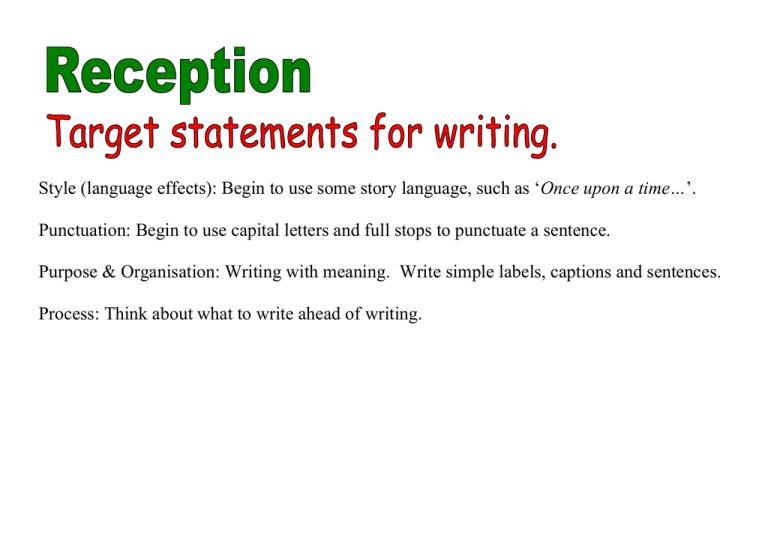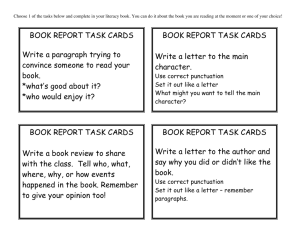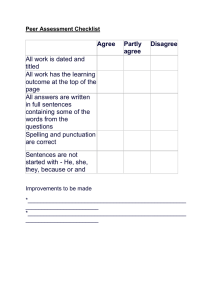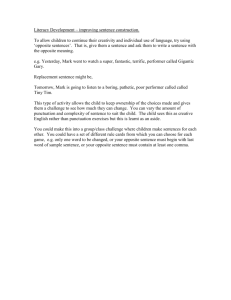Once upon a time…
advertisement

Style (language effects): Begin to use some story language, such as ‘Once upon a time…’. Punctuation: Begin to use capital letters and full stops to punctuate a sentence. Purpose & Organisation: Writing with meaning. Write simple labels, captions and sentences. Process: Think about what to write ahead of writing. Literacy Targets Record Sheet Target Name: Style (language effects): Begin to use some story language, such as ‘Once upon a time…’. Punctuation: Begin to use capital letters and full stops to punctuate a sentence. Purpose & Organisation: Writing with meaning. Write simple labels, captions and sentences. Process: Think about what to write ahead of writing. Whole year: Learning sounds and sound patterns in words. Whole year: Linking sounds to letters and engaging with stories; (e.g.) predicting, retelling, joining in. Year: Reception Style (language effects): Begin to use words appropriate to different text forms, (e.g.) story, report or simple instructions. Punctuation: Use capital letters and full stops when punctuating a single simple sentence. Purpose & Organisation: Write a recount or narrative. Begin to break up the series of events with connectives other than and. Process: Assemble information and ideas from own experience as a basis for writing, as well as generating questions prior to reading or writing. Literacy Targets Record Sheet Target Name: Style (language effects): Begin to use words appropriate to different text forms, (e.g.) story, report or simple instructions. Punctuation: Use capital letters and full stops when punctuating a single simple sentence. Purpose & Organisation: Write a recount or narrative. Begin to break up the series of events with connectives other than and. Process: Assemble information and ideas from own experience as a basis for writing, as well as generating questions prior to reading or writing. Autumn 1: Use knowledge of letter sounds to read and write simple (CVC) words. Autumn 2: Recognise and write simple sentences demarcated by capital letters and full stops. Spring 1: Blend and segment sounds in consonant clusters and use this knowledge in reading and writing. Spring 2: Understand the way that information texts are organised and use this in reading simple texts. Summer 1: Blend and segment long vowel phonemes and use with a range of other strategies to read and understand a complete text. Summer 2: Identify the main features of stories, including events, settings and common language patterns. Year: 1 Style (language effects): Consider and select from alternative word choices. Punctuation: Punctuate some sentences in the course of writing, using capital letters, full stops and question marks. Purpose & Organisation: Begin to show some characteristics of chosen form, incorporating appropriate language to sequence and categorise ideas. Process: Write initial jottings, notes and ideas before writing. Literacy Targets Record Sheet Target Name: Style (language effects): Consider and select from alternative word choices. Punctuation: Punctuate some sentences in the course of writing, using capital letters, full stops and question marks. Purpose & Organisation: Begin to show some characteristics of chosen form, incorporating appropriate language to sequence and categorise ideas. Process: Write initial jottings, notes and ideas before writing. Autumn 1: Read and spell words containing vowel digraphs and those with common endings (e.g.) –s, -ed, -ing. Autumn 2: Show understanding of how texts are sequenced. Spring 1: Use knowledge of the alphabet to locate information in dictionaries, indexes etc. Spring 2: Write accurate, simple sentences, where subject and verb agree. Summer 1: Read aloud with accuracy, fluency, and expression. Summer 2: Write a story in which characters and events are developed. Year: 2 Style (language effects): Use interesting vocabulary; vary use of adjectives and verbs for impact/effect. Punctuation: Demarcate sentences in the course of writing, using full stops, capital letters, question and exclamation marks, usually accurately. Purpose & Organisation: Write narrative with a build-up and complication that leads towards a defined ending, using a paragraph for each. Process: Use different planning formats, (e.g.) charting, mapping, flow charts, simple story boards. Literacy Targets Record Sheet Target Name: Style (language effects): Use interesting vocabulary; vary use of adjectives and verbs for impact/effect. Punctuation: Demarcate sentences in the course of writing, using full stops, capital letters, question and exclamation marks, usually accurately. Purpose & Organisation: Write narrative with a build-up and complication that leads towards a defined ending, using a paragraph for each. Process: Use different planning formats, (e.g.) charting, mapping, flow charts, simple story boards. Autumn 1: Express shades of meaning through effective use of verbs. Autumn 2: Recognise the main features of fiction and non-fiction texts and use them in their own writing. Spring 1: Recognise singular and plural forms of nouns and their effects on verbs. Use effectively in own writing. Spring 2: Use planning techniques to improve plot, characterisation and structure in stories. Summer 1: Use a range of strategies to spell words accurately and correct mis-spelt words in own writing. Summer 2: Use grammatical features of fiction and non-fiction texts consistently in writing. Year: 3 Style (language effects): Use powerful verbs to show character or add impact. Punctuation: Demarcate at least half of a written composition correctly, using the year 3 range of punctuation marks. Purpose & Organisation: Use paragraphs to structure narrative, for instance isolating an initiating event or introduction, followed by clear points leading to a conclusion. Process: Use different ways to plan writing, (e.g.) notes, diagrams etc. Literacy Targets Record Sheet Target Name: Style (language effects): Use powerful verbs to show character or add impact. Punctuation: Demarcate at least half of a written composition correctly, using the year 3 range of punctuation marks Purpose & Organisation: Use paragraphs to structure narrative, for instance isolating an initiating event or introduction, followed by clear points leading to a conclusion. Process: Use different ways to plan writing, (e.g.) notes, diagrams etc. Autumn 1: Identify and use correctly common suffixes which form adjectives, nouns, verbs, and adverbs. Autumn 2: Organise non-fiction writing for a specific purpose, using appropriate structural devices (e.g.) headings, paragraphs, layout. Spring 1: Identify and use expressive, figurative and descriptive language to create effects in poetry and prose. Spring 2: Use skimming, scanning and note taking to identify and present gist or key points. Summer 1: Understand how the meaning of sentences is shaped and marked by punctuation, word order and connectives. Summer 2: Recognise the ways writers present issues and points of view in fiction and non-fiction texts. Year: 4 Style (language effects): Use well-chosen phrases and vocabulary to engage the reader. Punctuation: Demarcate at least three out of four sentences correctly using the year 4 range of punctuation marks. Purpose & Organisation: Use paragraphs to structure plot, by shifting paragraphs for change of time, scene, action, mood or person. Process: Map text structures and lines of development. Literacy Targets Record Sheet Target Name: Style (language effects): Use well-chosen phrases and vocabulary to engage the reader. Punctuation: Demarcate at least three out of four sentences correctly using the year 4 range of punctuation marks. Purpose & Organisation: Use paragraphs to structure plot, by shifting paragraphs for change of time, scene, action, mood or person. Process: Map text structures and lines of development. Autumn 1: Edit writing to improve its quality and accuracy by adding punctuation, range of connectives and complex sentences. Autumn 2: Identify how language is used and structured in a range of texts, using such features in their own writing. Spring 1: Understand the differences between spoken and written forms, recognising how writing is adapted for different audiences and purposes. Spring 2: Recognise the characteristic language, structures and themes of different types of writing, adopting them in own writing. Summer 1: Use a range of different types of clauses, punctuated appropriately. Summer 2: Use knowledge of word derivation and formation to explain the meaning of words and spell them accurately. (prefixes, acronyms, letter omission etc.) Year: 5 Style (language effects): Use well-chosen phrases such as adverbials, adventurous or precise vocabulary and other techniques such as sentence variation or figurative language, to contribute to the overall effectiveness of the writing. Punctuation: Demarcate sentences correctly. Secure the use of the comma to demarcate grammatical boundaries, and to separate elements of sentences, short phrases or lists. Purpose & Organisation: Use paragraphs to distinguish the structure of different texts. Process: Plan quickly and effectively, including the conclusion. Literacy Targets Record Sheet Target Name: Style (language effects): Use well-chosen phrases such as adverbials, adventurous or precise vocabulary and other techniques such as sentence variation or figurative language, to contribute to the overall effectiveness of the writing. Punctuation: Demarcate sentences correctly. Secure the use of the comma to demarcate grammatical boundaries, and to separate elements of sentences, short phrases or lists. Purpose & Organisation: Use paragraphs to distinguish the structure of different texts. Process: Plan quickly and effectively, including the conclusion. Autumn 1: Recognise and use complex sentences, ensuring word choice, punctuation and use of grammar communicate clearly to the intended audience. Autumn 2: Understand how different layers of meaning created and use such features in their own writing. Spring 1: Adopt the appropriate formal tone in report or argumentative writing, by the use of grammatical constructions such as third person, passive voice or conditional clauses. Spring 2: Describe and evaluate authors’ use of techniques justifying interpretations by reference to the text. Summer 1: Investigate and understand the language conventions and grammatical features of a range of texts. Summer 2: Describe and evaluate a range of texts and authors, comment on style, theme, and appeal. Year: 6




